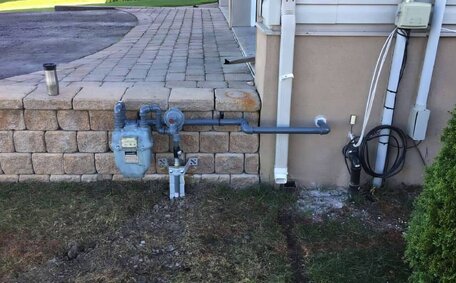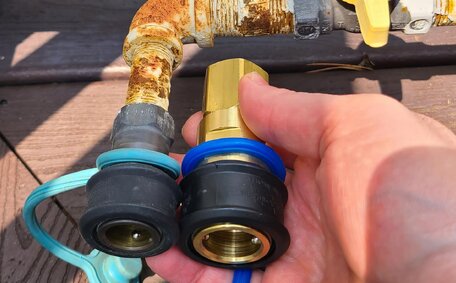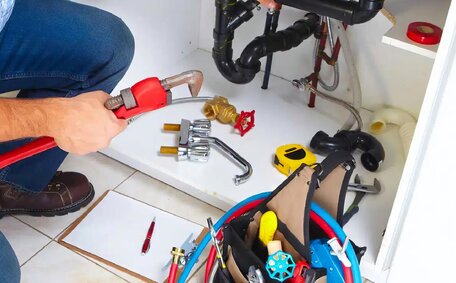How Seasonal Changes Affect Your Plumbing Systems
Fluctuating weather patterns in Marsfield, including temperature shifts, can significantly affect your plumbing systems. Autumn and spring’s wet weather can also overwhelm your drains, leading to backups or flooding.
During summer’s high temperatures, pipes may expand, which can result in leaks. During the coldest months, freezing temperatures can escalate into a burst pipe scenario or cause cracks.
Temperature fluctuations between seasons cause piping and fittings to repeatedly expand and contract. Over time, this wear and tear can diminish pipe integrity, leading to issues within your plumbing systems. Rust and corrosion also accelerate with exposure to seasonal moisture and condensation. Older pipes are especially vulnerable to breaking under these cyclic stresses.
Seasonal growth cycles for tree roots can also wreak havoc. Pruning roots strategically can mitigate this plumbing hazard.
Proactive upkeep ensures your plumbing is equipped to handle new seasons; identifying and reinforcing vulnerable pipes and joints is crucial. Engage in preventative plumbing practices to ensure your plumbing system remains secure by sealing openings, lagging pipes and clearing drains.
Before commencing seasonal garden renovations, conduct a comprehensive inspection of your plumbing systems.
Causes of Pipe Damage in Different Seasons
Certain seasons amplify the risk of pipe damage due to specific weather events and related factors. When soil becomes waterlogged it expands, placing extra pressure on buried pipes.
Such conditions can compromise older pipes or dislodge pipe joints.
Large seasonal temperature shifts also stress plumbing pipes.
PVC and metal pipes undergo expansion and contraction with temperature fluctuations, leading to small cracks and leaks over time, underscoring the value of trenchless solutions. Thermal shock from sudden temperature changes can also trigger a situation where even a resistant drain can fail.
As thick roots flourish over time, they may breach your sewer stormwater systems, leading to fractured lines and considerable damage.
Root cutting and installing barrier pipes offer a cost-effective remedy.
Prepare for impending seasonal threats by promptly identifying plumbing vulnerabilities. Be vigilant for early signs like damp patches.
Don’t hesitate to give us a call for our plumbing service today; Our professionals can perform pipe inspections and reinforce your plumbing when required.
Winter Weather and Its Impact on Pipes
The extreme cold of winter brings unique hazards, threatening your water supply integrity. When temperatures drop below freezing, making a choice like relining vs traditional repair methods is crucial as water inside pipes expands putting tremendous pressure on materials. If your plumbing system lacks insulation, the water can freeze and expand even further until pipes crack or burst.
Prepare your plumbing for winter by considering relining solutions and insulating pipes in unheated spaces like crawl spaces and attics. Insulate pipes most prone to freezing first, like Outdoor hose bibs, washing machine lines and pools/spa setups are often scrutinised during a routine sewer line repair.
For extreme sub-zero cold, let indoor faucets drip slowly so water stays moving within pipes. Opening cabinet doors below sinks maintains warmer space temperatures around pipework. Maintain heat in your home during cold snaps, even while away, setting no lower than 12°C.
Catching small leaks early and insulating vulnerable pipes prevents major winter damage needing pipe relining down the track. If you encounter ice buildups, saltwater trickling, or a sudden dip in water flow, call us right away to address and reinforce the affected areas.
How Hot Summer Temperatures Can Damage Pipes
Similarly, during winter, frigid temperatures can cause pipes to contract and potentially crack. As materials expand, they become susceptible to cracks and burst joints. Plastic pipes warp and ductile iron pipes swell triggering leaks.
The intensifying heat strain during drought periods evaporates soil moisture and increases the risk of burst pipes on your property. Foundations shift placing added pressure on buried pipes. Summer also sees a spike in water usage, potentially eroding pipe interiors due to increased flow velocity.
Add shade covers to exposed outdoor piping. Be alert to small leaks, which often signal an overexpansion of pipes.
Install pressure relief and thermostatic valves on your water heater that open when exceeding safe thresholds. Protect pipes by lagging with insulation to reduce heat transfer.
Proactive checks and maintenance before the height of summer can thwart extensive pipe damage.
Maintaining cool pipes enhances their integrity and reduces the future need for major relining.
Signs Your Pipes May Need Relining
There are several clear signs indicating your pipes urgently need relining. Gurgling sounds from toilets or sinks may suggest the presence of partial blockages. Sewage odours indoors typically imply there are broken pipes or misaligned joints permitting gas to escape.
Ongoing problems like blocked drains or slow drainage often indicate pipe damage due to tree roots or debris-catching cracks.
Damage to flooring near toilets, bathtubs, and sinks can hint at concealed water exposure.
If you witness dripping pipes, evident cracks, extensive rust, or peeling pipe insulation causing water to back up, halt use immediately to prevent further damage. Call a plumber to inspect with a drain camera. From this assessment they can judge if pipe relining is needed to reinforce compromised pipes and prevent catastrophic failure down the track.
Preventative Measures for Seasonal Pipe Damage
You can take proactive steps to safeguard pipes from seasonal threats. Perform drain cleaning by clearing debris like leaves from gutters and downpipes before autumn rains arrive to prevent flooding damage. Insulate outdoor taps and pipes in your garden most prone to winter freezes using foam covers.
During spring, check outdoor pipe joints for root encroachment or leaks. Seal any cracks found with protective wraps to forestall further deterioration.
Apply UV, heat and corrosion protective coatings to exposed pipes. Lagging wraps reduce temperature fluctuations that degrade pipework. Regular checks on insulated pipes for damp spots can reveal insulation faults needing attention.
Schedule preventive maintenance checks with drain cameras to spot and rectify vulnerabilities before seasonal changes. Installing protective measures in advance of seasonal extremes lessens the likelihood of serious pipe failures needing emergency relining down the track.
Maintenance Tips for Protecting Pipes
Proper maintenance prepares your plumbing systems for seasonal extremes and prevents the deterioration that can necessitate relining. Insulate exposed pipes before winter arrives, using quality lagging to regulate temperature fluctuations causing material fatigue.
Come spring, closely inspect pipe joints and address even minor tree root intrusions. Pruning back encroaching branches stops invasive root damage, protecting pipes without need for frequent repairs. Seal any exterior cracks found to prevent further water infiltration and deterioration of the sewer pipe.
Consider installing root barriers when landscaping, which block root access to pipes. Have plumbers conduct a thorough analysis, considering options like pipe relining vs traditional methods before seasonal changes, to identify vulnerabilities early. Addressing weaknesses proactively reduces pipe failures and emergency relining needs when weather events hit.
Learn signs of trouble like damp patches indicating leaks. Monitor usage on utility bills for spikes suggesting silent leaks, such as from your toilet or other fixtures. Keeping insulation, joints and coatings well-maintained ensures longevity of your plumbing systems.
Identifying Pipe Issues Early
Detecting minor pipe problems early is crucial before they escalate into major faults needing pipe relining. We use CCTV drain inspections to identify issues, providing abundant knowledge about pipe health not visible during standard maintenance.
A drain camera affords a comprehensive view inside the pipes, helping to pinpoint various issues from misalignments to root intrusions that signal potential early failure. Pinpointing weaknesses early allows for targeted spot repairs and reinforcement.
Look for red flags like gurgling noises, slow drains, damp patches and higher water bills indicating potential hidden issues. Ignoring minor leaks can lead to progressive corrosion within pipe interiors. Catching problems when small prevents expensive relining and digging later.
Schedule periodic CCTV pipe check-ups to stay ahead of deterioration. We also offer thermal imaging to map vulnerable hotspots prone to future leakage. Preventative maintenance keeps pipes integrity maximised all year round for longevity, averting major disasters down the track.
Knowing When to Call a Plumber
When you observe any indications of potential plumbing complexities that could need relining, it’s best to contact a professional plumber for an inspection and diagnosis. At Marsfield Plumbing, our expert technicians have the skills and technology, like CCTV drain cameras, to accurately assess pipe damage and deterioration.
We recommend contacting our team to learn about the benefits pipe relining offers if you notice red flags like damp patches on walls or ceilings, higher water bills, foul sewage odours indoors, chronic clogged drains, or leaks. Catching problems early allows for minor repairs rather than expensive emergency pipe relining down the track.
Should concerning symptoms or seasonal changes arise, give us the opportunity to book an inspection and possibly reline pipes. Our preventative maintenance services proactively identify vulnerabilities in your plumbing systems before catastrophic failure occurs. We also offer after-hours emergency support.
Opting for plumbing services from local plumbers committed to the community guarantees reliable, quality service suited to Marsfield’s specific conditions. With over a decade serving Sydney, no company knows and cares for what’s under your home like the team at Marsfield Plumbing.
The Pipe Relining Process and Benefits
Pipe relining revamps old piping from within using a trenchless repair technique. An epoxy resin does more than reline; it provides a robust defence for pipes suffering deterioration, damage or tree root invasion.
The process of pipe lining involves our technicians first using a CCTV drain camera to inspect the damaged section of pipe and determine if it meets criteria for relining. An access point is then utilized, typically through an existing cleanout or manifold, for the relining process.
A flexible epoxy-soaked liner, specific to the section pipe needing repair, socked with protective coating is fed through the pipe. The liner expands within sewer pipes, bonding to form a smooth, watertight seal. Once hardened, the relined section is impervious to future root intrusion or corrosion.
Relining fortifies your pipes, enhancing structural stability, flow capacity, and potentially extending their service life by over 50 years. The cured epoxy withstands your water heater’s hot water, chemical exposure, and the abrasion found in busy sewer systems. With no trenches or digging required, it’s a cost-effective pipe repair solution.
Reach out to Marsfield Plumbing to explore relining solutions that circumvent the need to excavate your yard for new pipe installations. Our trenchless experts can assess if your pipes are suitable candidates for this durable no-dig repair method. We also offer traditional pipe replacement if full extraction is needed.






